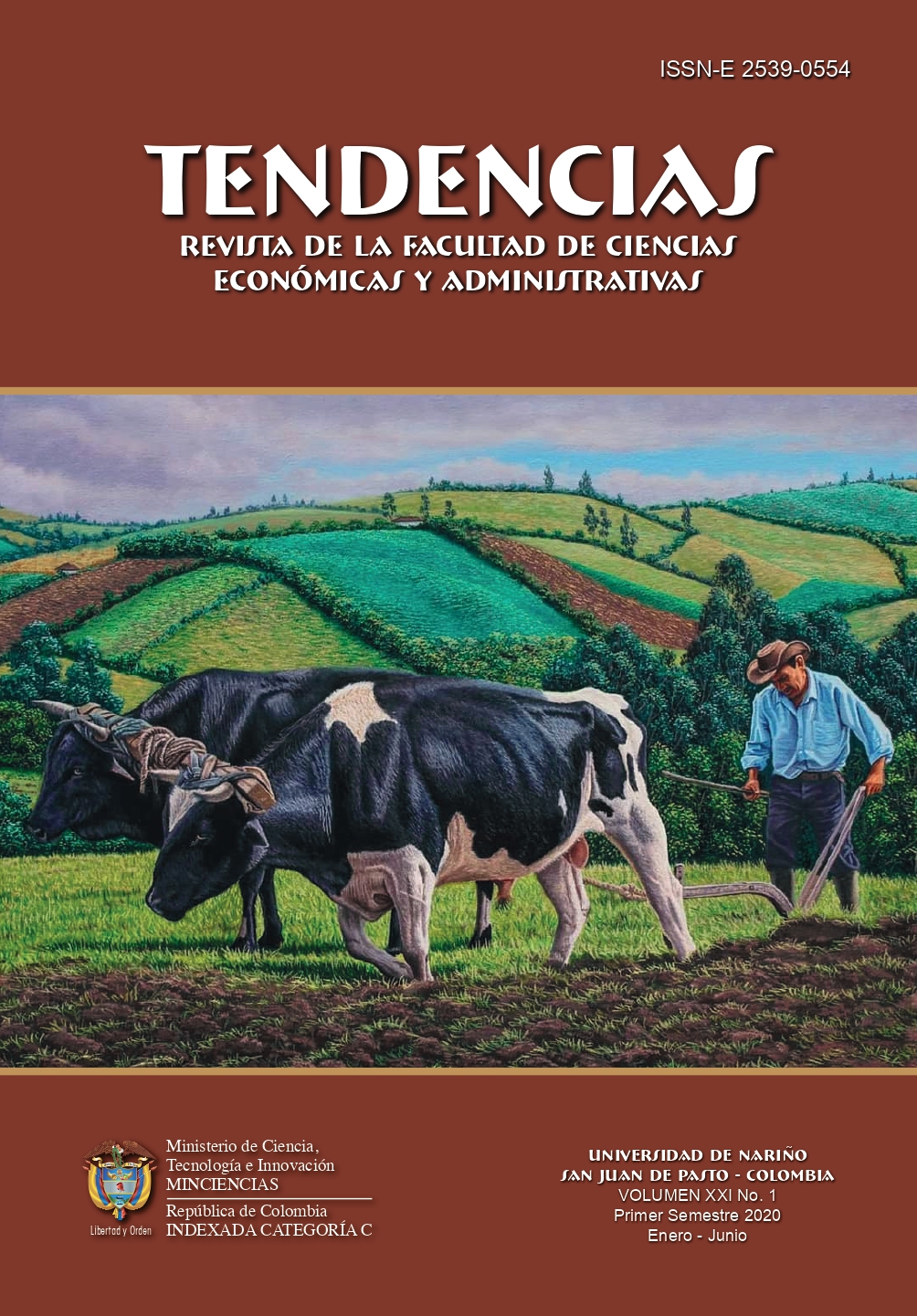The importance of family networks on the reunification processes for Latin-americans in the United States
DOI:
https://doi.org/10.22267/rtend.202101.127Keywords:
international migration, demographic trends and forecasts, general statistical models, survival analysisAbstract
The migratory processes incorporate different strategies that modify the probabilities of a new emigration. The existence of a support network, in many cases of family members, works as a mechanism to promote migration. The objective of this study is to detail which reunification events are common in the displacement of families and how much time elapses between the most common reunifications; that is, between spouses or between parents and children. To achieve this, the reunification with the information from the IPUMS-I and IPUMS-USA databases is studied. The first, allows analyzing the composition of households and observes the role of sex by type of reunification, and the second, details which variables influence the reunification time of the mentioned categories. The results show the predominance of specific types of household and the change in trend over time, as well as the significant variables in the increase or decrease in the risk of reunification.
Downloads
References
(1) Arriagada, I. (2007). Familias latinoamericanas: cambiantes, diversas y desiguales. Papeles de Población, 13(53), 9-22
(2) Bakewell, O. (2014). Re-launching migration systems. Migration Studies. 2(3), 300–318
(3) Canales, A. (2017). La migración internacional en los modelos neoclásicos. Una perspectiva crítica. Huellas de la Migración, 2(3), 11-36.
(4) De Vos, S. (1987). Latin American Households in Comparative Perspective. Population Studies, 41(3), 501-517
(5) Domingo, A., y Bayona, J. (2010). Los hogares de la población de nacionalidad extranjera en España en el año 2001. Papers de demografía, 95(3), 731-754.
(6) Frizzell, R.W. (1987). "Migration Chains to Illinois: The Evidence from German-American Church Records". Journal of American Ethnic History, 7(1), 59–73.
(7) Giorguli, S. y Bautista, A. (2018) Radiografía de la migración de retorno 2015. Notas para la integración de los retornados. Número 1. Sistema Nacional de información sobre migración de retorno y derechos sociales, barreras para la integración. https://migracionderetorno.colmex.mx/indicadores/, Última consulta: 14/09/19.
(8) Gurak, D., y Kritz, M. (2016). Pioneer settlement of US immigrants: Characteristics of pioneer migrants and places. Demographic Research. 34(25), 705−740
(9) Herrera. G. (2011). Cuidados globalizados y desigualdad social reflexiones sobre la feminización de la migración andina. Nueva Sociedad, 233, 87-97.
(10) Hedström, P., y P. Bearman, eds. (2009). What is Analytical Sociology All About? An Introductory Essay. En libro: The Oxford handbook of analytical sociology. Oxford University. Nueva York, Estados Unidos.
(11) Jasso, G. y Rosenzweig, M. (1986) Family Reunification and The Immigration Multiplier: U.S. Immigration Law, Origin-Country Conditions, And The Reproduction of Immigrants. Vol 23, Num 3, pp. 291-311. https://doi.org/10.2307/2061432.
(12) Kritz, M., Lim, L., y Zlotnik, H. (1992) International Migration Systems: A global approach. Oxford University Press. Nueva York, Estados Unidos.
(13) Laslett, P. y Wall, R. (1972). Household and Family in Past Time. Cambridge University Press. https://doi.org/10.1017/CBO9780511561207
(14) León, F. (2016). No más barcos de Coleman. Repensando las relaciones micro-macro. Memorias del XII Congreso Español de Sociología. Gijón (ESP).
(15) Mabogunje, A. (1970). Systems Approach to a Theory of Rural-Urban Migration. Geographical Analysis, 2(1) 1–18.
(16) Massey, D. (1990). Social Structure, Household Strategies, and the Cumulative Causation of Migration, Population Index, 56(1), 3-26.
(17) Massey, D., y Aysa, M. (2011). “Social Capital and International migration from Latin America”. International Journal of Population Research, International Journal of Population Research, 2011(834145), 1–18.
(18) Martínez, J. (2001) Reflexiones sobre la gobernabilidad de la migración internacional en América Latina. Migraciones Internacionales, ISSN-e 1665-8906, Vol. 1, Nº. 1, págs. 88-110
(19) Minnesota Population Center (2018). Integrated Public Use Microdata Series, International: Version 7.1 [dataset]. Minneapolis, MN: IPUMS. https://doi.org/10.18128/D020.V7.1
(20) Nobles, J. (2013). Migration and Father Absence: Shifting Family Structure in Mexico. Demography, 50(4), 1303–1314. doi:10.1007/s13524-012-0187-8
(21) Oso, L. (2008) Migración, género y hogares transnacionales. En libro: La inmigración en la sociedad española: una radiografía multidisciplinar. págs. 561-586. Ediciones Bellaterra.
(22) Pekin, H. (1989). Effects of Migration on Family Structure. International Migration, 27(2), 281–293. doi:10.1111/j.1468-2435.1989.tb00257.x
(23) Prieto, V., Pellegrino, A., y Koolhaas, M. (2015) Intensidad y selectividad de la migración de retorno desde España y los Estados Unidos hacia América Latina. En libro: Retorno en los procesos migratorios de América Latina. Conceptos, debates y evidencias. Serie de investigaciones No. 16. Editorial: ALAP – Asociación Latinoamericana de Población.
(24) R Core Team (2017). R: A language and environment for statistical computing. R Foundation for Statistical Computing, Vienna, Austria. URL https://www.R-project.org/.
(25) Rass, C. (et al.). (2018). What Is in a Migration Regime? Genealogical Approach and Methodological Proposal. En libro: Was ist ein Migrationsregime? What Is a Migration Regime? Springer Fachmedien Wiesbaden;Springer VS.
(26) Recaño, J. (2002). El papel de las redes en los procesos de migración interna. Revista de Demografía Histórica, 20 (1), 15-20.
(27) Ruggles, S., Genadek, K., Goeken, R., Grover, J., and Sobek, M. Integrated Public Use Microdata Series: Version 6.0 [dataset]. Minneapolis: University of Minnesota, 2015. http://doi.org/10.18128/D010.V6.0.
(28) Takenaka, A., y Pren, K. (2010). Determinats of Emigration: Comparin Migrants' Selectivity form Peru and Mexico. American Academy of Political and Social Science, 630, 178-193.
(29) Wallerstein, I. (1979). El moderno sistema mundial: la agricultura capitalista y los orígenes de la economía europea en el siglo XVI. Madrid, Siglo XXI.
(30) Woodward, M. (2014). Epidemiology: Study, Design, and Data Analysis. Taylor and Francis Group.
Published
How to Cite
Issue
Section
License
Those authors who have publications with this journal, accept the following terms:
This journal is licensed under a Creative Commons Reconocimiento-NoComercial 4.0 Internacional License. The articles can be copied, distributed, adapted and communicated publicly, as long as the credits of the work are recognized and the respective source is quoted. This work can not be used for commercial purposes.
To increase their visibility, documents are sent to databases and indexing systems.
The content of the items is the responsibility of each author, and does not compromise in any way, journal or institution.







































